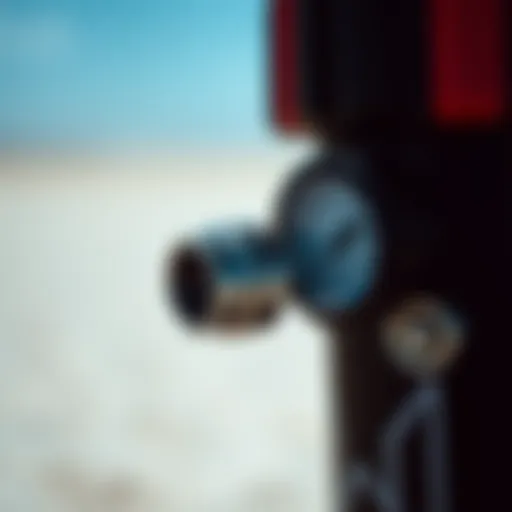Discovering Kite Surfing Adventures in the Maldives
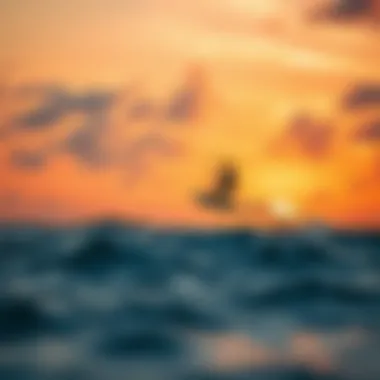
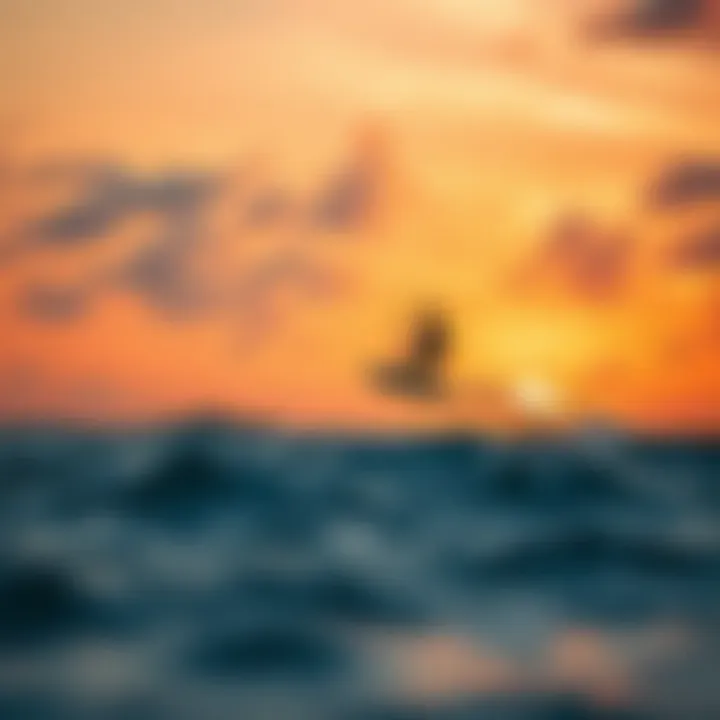
Intro
Kite surfing is more than just an adrenaline-pumping sport; it's a harmonious blend of artistry and science, especially in the Maldives, where the azure waters resume like a painter's canvas. The geography of this enchanting archipelago offers a unique playground for both beginners and experts alike. Riding the waves in these spectacular surroundings is an experience that few can replicate. Dotted with a multitude of atolls, the beaches here boast steady winds, shallow lagoons, and breathtaking sceneries.
For those who feel the tug of the ocean beneath their feet, this guide aims to unravel the intricate details of kite surfing in the Maldives. From the best equipment to invest in to essential tips to navigate the winds and waves safely, we will cover everything a kiteboarder needs to elevate their experience.
Winding through kite surfing techniques and local customs, we'll ensure you understand the nuances that make this destination so special. Sustainability matters too, as it’s crucial to keep this paradise pristine for future generations and riders alike. There's no shortage of information to explore; hence, let’s set sail into the heart of kite surfing in the Maldives.
Gear Insights
When it comes to kite surfing, the right gear can make or break your experience. Let’s dive into what you should consider whether you’re just starting or looking to level up your experience.
Latest Gear Reviews
The market for kiteboarding equipment can seem overwhelming, with brands like North Kiteboarding, Duotone, and Cabrinha offering products that range in features and price points. Recent reviews of the Duotone Rebel indicate it is quite the performer in various wind conditions, catering to riders looking for versatility.
On the other end, the Cabrinha Switchblade continues to receive praise for its stability and ease of use, marking it as a solid choice for those venturing into choppy waters. For a more budget-friendly option, consider the Slingshot Rally, which offers a satisfying performance without breaking the bank.
Considerations when Buying Gear
- Kite Size and Type: Depending on your weight, skill level, and wind conditions, the kite size might vary. A common recommendation is a medium-sized kite ranging between 9-12 meters for most riders.
- Board: Different shapes and sizes of boards affect your performance. A twin-tip board is often favored for its versatility.
- Harness: Comfort plays a key role; pick a harness that fits well and provides good back support.
Essential Gear for Beginners
Starting out requires some basic equipment to ensure safety and enjoyment:
- Kite: Opt for a beginner-friendly kite that is stable and user-friendly.
- Board: A larger board can make learning easier, providing a better balance while you're getting adjusted.
- Safety Leash: Don’t skimp on safety; a quality leash can save you from losing your kite in rough conditions.
- Wetsuit: Depending on the season, a wetsuit can keep you warm and protected against abrasions.
Techniques and Tips
Kite surfing is as much about skill as it is about equipment. With practice and the right techniques, you can hone your skills and enjoy your time on the water.
Advanced Tricks and Techniques
As you advance, you might be eager to take on some tricks:
- Jumping: Timing is everything; pull down on the back lines as you send your kite upward.
- Board Offs: This trick involves taking your board off while in the air and placing it back before landing.
Safety Practices for Kiteboarders
Keeping safety at the forefront is paramount, especially when experiencing the thrill of the sport:
- Know the Conditions: Before hitting the water, always check local wind and current conditions. Knowledge is power.
- Respect Wildlife: Be aware of local marine life and avoid bothering them, keeping ecosystems intact.
Utilizing these tips and insights will enhance your kite surfing journey, enabling you to embrace the Maldives’ stunning waters fully. Make sure to be observant for other riders, locals, and guidelines; after all, an adventure is best enjoyed with awareness and respect.
"The best kite surfers are always learning and adjusting; but more importantly, they are enjoying the ride."
As we move forward, understanding local customs and practices will help enrich your experience even further.
Preface to Kite Surfing
Kite surfing is not just a sport; it’s a thrilling experience that combines elements of surfing, windsurfing, and paragliding. This article aims to explore the various facets of kite surfing, particularly in the breathtaking setting of the Maldives. As an adventure sport, kite surfing attracts a diverse group of enthusiasts, ranging from seasoned riders seeking new challenges to beginners taking their first flight. Understanding the intricacies of this sport is vital for anyone interested in making the most of their experience in these stunning waters.
The importance of kite surfing lies not only in the adrenaline rush it provides but also in its ability to connect individuals with nature. Imagine gliding across crystal-clear waters, with the wind in your hair and the sun on your face. The vastness of the ocean paired with the power of the wind can make for a uniquely liberating experience. For hobbyists and thrill-seekers alike, kite surfing offers both a physical challenge and a sense of community among those who share the passion for the sport.
When exploring the Maldives specifically, several elements come into play. The geographical location of the islands, their wind patterns, and water conditions create a kiteboarding paradise that is hard to rival. For example, the ease of access to shallow lagoons makes it beginner-friendly while still providing challenging conditions for more experienced kite surfers. This duality is one of the key attractions for travelers looking to dive into the world of kite surfing.
Among the vast benefits are:
- Accessible Learning Environment: Ideal conditions for beginners and advanced riders alike.
- Stunning Landscapes: The breathtaking views of the Maldives enhance the overall experience.
- Community and Culture: Meeting locals and fellow kite surfers enriches one's journey, making it more than just a sport.
Before one jumps into the thrill of kite surfing, it’s essential to consider safety measures and the necessary equipment. Understanding local customs and respecting the ocean environment are also significant aspects that could affect your kite surfing adventure, not to mention the preservation of this delicate ecosystem.
In summary, kite surfing in the Maldives is more than just catching wind and waves; it’s about embracing the adventure, connecting with the surroundings, and always pushing one’s limits. This article will serve as a comprehensive guide to ensure that both novices and experts can take full advantage of what kite surfing in this island paradise has to offer.
Understanding the Maldives as a Kiteboarding Destination
Kiteboarding in the Maldives is not just about the thrill of gliding over turquoise waters; it’s about engaging with a paradise that harmoniously melds natural beauty and dynamic wind conditions. This section aims to explore the various offerings of the Maldives as a premier kiteboarding destination, showcasing its unique advantages and essential considerations that every kite surfer must keep in mind.
Geographical Features
The Maldives, comprising 1,200 islands scattered across 90,000 square kilometers of ocean, presents a landscape that is almost tailor-made for kiteboarding. With its low-lying atolls, crystal-clear lagoons, and consistent wave patterns, kiteboarders of all skill levels find ideal conditions to hone their craft.
Water depth varies across the islands, providing options for beginners and pros alike. Some spots, with shallow lagoons, create a perfect playground for novices to practice their technique without worrying too much about deep waters. On the other hand, experienced riders can seek out areas with waves that challenge their skills and push their limits.
It’s also important to consider the overall layout of the atolls, as they create natural wind tunnels that can amplify wind speeds, making for exhilarating rides, especially during the peak wind seasons. The geography enhances visibility for riders, allowing them to spot other water sports enthusiasts or local fishermen, which is crucial for safety.
Climatic Conditions
The weather in the Maldives generally supports a year-round kiteboarding experience, but understanding the nuances of its climatic patterns can significantly enhance your adventure. The Maldives enjoys a tropical climate characterized by two main seasons: the northeastern and southwestern monsoons.
Northeastern Monsoon (November to April):
During this period, you can expect stronger winds, often reaching up to 25 knots. This season is favored by kiteboarding enthusiasts, with conditions ideal for advanced riders looking to test their techniques against more challenging winds.
Southwestern Monsoon (May to October):
Though the winds can be milder in this season, averaging around 15 knots, it still caters to a diverse range of riders. Beginners will find this an inviting time to learn, with gentle breezes allowing for gradual skill development.
It's essential to keep an eye on local weather forecasts and tide tables. Sudden weather changes can pop up despite the general predictability, so being prepared is key. Familiarizing yourself with local wind patterns can give you an edge and contribute to a safer kiteboarding experience.
As you venture into the expanses of this island nation, you will quickly realize that each kiteboarding session is not just a sport; it’s an encounter with the Maldives' breathtaking environment, where every gust of wind carries the essence of adventure.
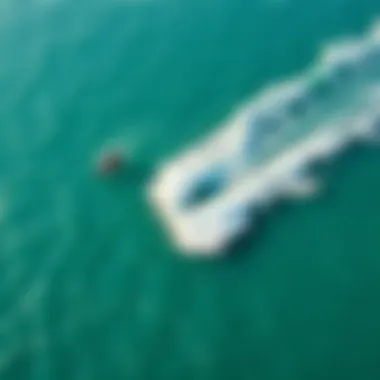
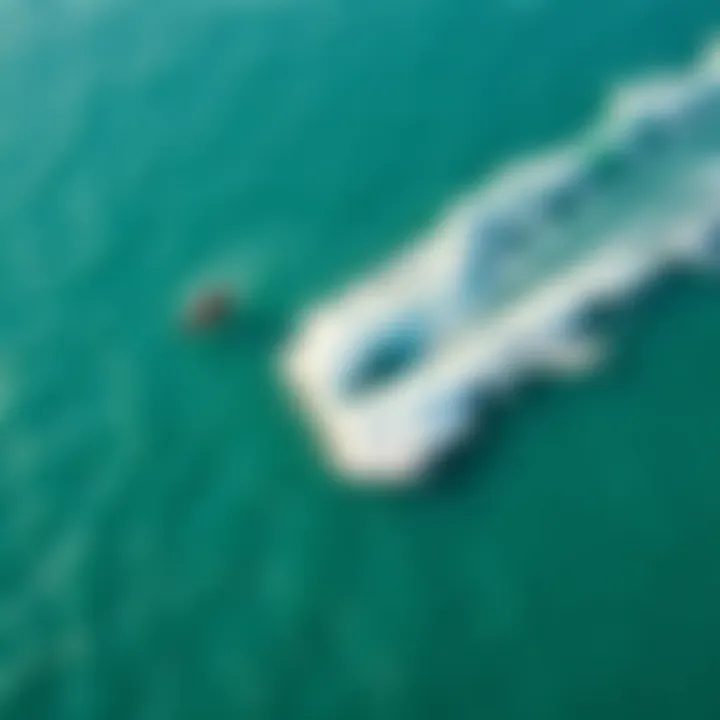
Best Kite Surfing Spots in the Maldives
Kite surfing in the Maldives is not just a sport; it's a way to connect with the natural beauty of the ocean while testing your skills against the wind and waves. The emphasis on locating the best kite surfing spots stems from both practicality and enjoyment. Each site presents a unique mix of wind patterns, wave types, and ocean conditions, making it crucial to find a location that matches your ability and preference.
For kite surfers, the right spot can mean the difference between a challenging day on the water and a thrilling adventure. The Maldives offers a plethora of options, but a few stand out above the rest. Let's take a closer look at some of the top locations:
North Male Atoll
North Male Atoll is perhaps one of the most legendary kite surfing locations in the Maldives. This area is well-known for its consistent wind conditions and stunning views. The turquoise waters are inviting, combined with the plethora of resorts and schools, making it a hotspot for enthusiasts of all levels.
- Wind Conditions: Generally, from November to May, the wind blows steadily, creating ideal conditions for kite surfing. Middle of the day sees stronger winds, perfect for those who want to push their limits.
- Sailing to the Spot: Many kite surfers opt for boat trips from local resorts, leading to secluded spots where you can ride away from larger crowds. There’s nothing like being surrounded by nothing but a vast ocean.
- Local Facilities: Numerous schools and rental shops ensure that you can grab equipment easily, or even sign up for a quick lesson. It’s easy to mingle with locals and other kite surfers, making this a vibrant community.
Ari Atoll
Ari Atoll presents another gem for kite surfers, with its range of idyllic islands and pristine beaches. The area is famous for its jaw-dropping lagoons and diverse marine life, alongside fantastic wind conditions.
- Ideal Weather: The wind pattern here is reliable, particularly during the dry season. With steady winds reaching 15-25 knots, kite surfing enthusiasts can find their groove easily.
- Great for All Skill Levels: Whether you're just starting or are an advanced rider, Ari Atoll caters to all. Several recommended spots along the atoll offer flat water for beginners and larger waves for experienced surfers.
- Additional Attractions: Beyond kite surfing, the surrounding coral reefs are a hive of activity, perfect for scuba diving or snorkeling when you need a break from the kite.
Thulusdhoo
Thulusdhoo is a lesser-known spot that is gaining traction among kite surfers. This island offers unique wave conditions and is attractive both for its surf culture and kiteboarding opportunities.
- Wave Action: Known for its reef breaks, Thulusdhoo allows more advanced kitesurfers to engage with challenging wave conditions, making it a thrilling adventure.
- Local Culture: The island is inhabited by locals who are friendly and welcoming, offering a slice of authentic Maldivian life. Here, one can learn about local customs while enjoying the sport.
- Accessibility: Though it may require a bit more effort to reach, various transportation options from nearby islands are available, making it a spot worth seeking out, especially for those looking to escape the more crowded areas.
Finale
These spots represent just a slice of what the Maldives has to offer for kite surfers. The variations in wind conditions, oceanography, and cultural exposure create a rich tapestry for all adventure seekers. When planning your trip, it’s essential to assess not only your personal skills but also the unique characteristics of each location. Making the right choice enhances the experience, ensuring every moment spent in the water is as exhilarating as it should be.
Kiteboarding Seasons and Wind Conditions
Kiteboarding in the Maldives offers an exhilarating experience tailored to suit various skill levels, but it's crucial to understand the influence of seasons and wind patterns on this sport. Knowing when the winds are favorable can significantly boost your enjoyment and safety on the water. Each season brings different wind strengths and directions, making it essential to select the right time for your kite surfing escapade.
Optimal conditions not only enhance your performance but also mitigate risks associated with kiteboarding, especially for those who are still learning the ropes. Mastering the seasons will help you select the best gear and prepare adequately for your sessions, ensuring that you tailor the experience to your personal needs and abilities.
Seasonal Winds Overview
The winds in the Maldives have a rhythm of their own, tied closely to the monsoon seasons; generally, you’ve got the northeast monsoon from November to March, and the southwest monsoon from May to October.
- Northeast Monsoon (November - March): This period is arguably the prime time for kite surfers. Winds blow consistently at 15-25 knots, offering fantastic conditions for intermediate and advanced riders. The clear skies and warm waters add to the allure, making it a popular season for kiting enthusiasts. You might even find yourself grinning from ear to ear while cutting through the waves at Kuredu or Kanuhura.
- Southwest Monsoon (May - October): The wind conditions can be more variable during this stretch, with unpredictable gusts and often lighter winds, generally averaging around 10-18 knots. Beginners may find the conditions less daunting, as lighter winds are often more manageable. This period also offers some unique opportunities such as the spectacular marine life sightings that can be enjoyed in the waters, making it a delightful time for less rigorous kite surfing and exploration.
Factors such as geographical positioning and local islands can also influence how the wind conditions play out on the water. So it's wise to keep an eye on localized forecasts.
Ideal Conditions for Beginners
For beginners stepping into the world of kite surfing, the ideal conditions center around controllable wind speeds and serene water surfaces. Here’s what to consider:
- Wind Speeds: Generally, wind speeds in the range of 10 to 15 knots are considered perfect for newcomers. This allows you to safely practice basic maneuvers without the overwhelming force of stronger winds.
- Flat Water Areas: The Maldives hosts numerous lagoons and flat water spots, such as those found in Thulusdhoo, which are veritable playgrounds for beginners. These calmer areas let you focus on learning without the added aggravation of chopping waves.
- Warm Water Temperatures: The inviting warm waters provide an added comfort factor; who wants to deal with shivering while trying to figure out kite control?
- Training Facilities: Consider schools that offer beginner courses, especially those that schedule lessons during these calmer months. They often provide the right equipment tailored to your skill level and a safe learning environment.
In summary, choosing the right season not only enhances your kiteboarding experience in the Maldives but also provides a structured learning path for those just starting out. Knowing when to go gives you the upper hand in enjoying all the breathtaking beauty of the waters while riding the winds.
"A smooth sea never made a skilled sailor." - This adage rings especially true for kite surfers; the right conditions will build your confidence and competence on water.
For further details about the best times to visit the Maldives for kite surfing, check the comprehensive resources available on Wikipedia or Britannica.
The thrill of kite surfing the stunningly beautiful waters of the Maldives awaits, so plan accordingly and let the winds guide you!
Essential Gear for Kite Surfing
Kite surfing in the Maldives isn’t just about riding the waves; it’s about having the right gear to ensure a safe and enjoyable experience. Understanding the essential gear is crucial because it amplifies performance and provides considerable benefits in the unique conditions of the Maldivian waters. Selecting the correct equipment not only enhances your adventure but also emphasizes safety while navigating the vibrant lagoons.
Kites and Boards Explained
When it comes to kite surfing, the kite and board are the heroes of the tale. Just like a fisherman wouldn't head out to sea without a rod, a kite surfer should not hit the water without the right hardware.
- Kites: The type of kite plays a significant role in your experience. Kites come in various shapes and sizes, generally classified into three main categories:Each kite comes with different characteristics, and understanding your preferences can dramatically enhance your performance. Remember, size matters! A larger kite will generate more power but can be cumbersome in strong winds.
- Boards: The board is another vital piece of equipment. Options range from freestyle boards that allow for tricks to directional boards better suited for waves. When selecting a board, consider factors such as:
- Inflatable Kites: These are the most popular option, known for their stability and ease of use. They provide a large surface area, making them suitable for a range of wind conditions.
- Foil Kites: For those with a thirst for speed and unique performance, foil kites are lightweight and excellent in low wind speeds. However, they require a bit more skill to control.
- Hybrid Kites: These kites combine features from both inflatable and foil kites, offering versatility for different riding styles.
- Length: Generally, longer boards provide more stability and support, while shorter boards are quicker and more agile.
- Width: Wider boards offer better floatation, making them ideal for beginner riders.
- Flex: Flexibility in boards impacts your handling and control. A stiffer board tends to be more responsive.
Safety Equipment
Safety should never take a back seat while enjoying the thrill of kite surfing. Fortunately, there are several key pieces of safety equipment that one should not overlook.
- Harness: A comfortable harness is necessary to hold you securely to the kite while allowing for movement without strain. Harnesses come in two primary types: waist and seat harnesses. A waist harness sits higher on your body and offers better mobility, while a seat harness is more stable for novice riders.
- Impact Vest: An impact vest acts like an airbag in case of sudden falls or crashes. It serves to cushion your body against the water. In the Maldives, where the waters can be enticingly warm, wearing an impact vest that is buoyant adds an extra layer of safety.
- Helmet: While helmets might not be common among all riders, they are invaluable for beginners or those venturing into crowds. Protecting your head from unforeseen bumps is wise, especially in a bustling spot like the Maldives.
- Leash: A kite leash secures your kite to you should you accidentally drop it. This piece of equipment is essential because it helps maintain control and prevent damage to your kite, ensuring a safer experience for everyone out on the water.
By equipping oneself with the proper gear, availability in the Maldives is plentiful. When tailored correctly, gear can facilitate an unforgettable hobby and deepens the immersive experience amongst those beautiful atolls. As kite surfing continues to grow in popularity, being prepared with solid equipment doesn't just enhance your individual experience but also contributes positively to the overall kite boarding community in the Maldives.
"Having the right gear is like having a good compass; it not only guides you but keeps you on the right track toward your adventure."
Learning to Kite Surf
Kite surfing is not just a thrilling adventure; it’s an art that combines skill, balance, and a bit of courage. Mastering the basics is the key for any kiteboarder, making this section essential. Learning to kite surf introduces enthusiasts to the wind and water dynamics. The Maldives, with its pristine waters, serves as an exceptional classroom. The excitement of harnessing the wind to glide across the blue waters can be life-changing.
Understanding foundational techniques and safety standards greatly enhances the enjoyment of the sport. Furthermore, kite surfing in the Maldives can be tailored to suit all skill levels, from the curious beginner to the accomplished rider looking to refine their craft.
Beginner Lessons
For beginners, taking lessons from certified instructors is crucial. A structured program often includes:
- Theory Sessions: This provides knowledge of wind patterns and how to handle the equipment. Understanding the anatomy of a kite and board is foundational.
- Safety Protocols: Learning emergency procedures and basic first aid is critical. It’s wise to know how to safely launch and land a kite, and understand the wind window.
- Hands-on Practice: Starting on land, novices learn to control the kite. Most instructors set up a controlled environment, often at spots with flat waters and less crowd.
- Water Sessions: Finally, under guidance, students hit the water. They learn how to ride on the board, practicing balance and steering with their body.
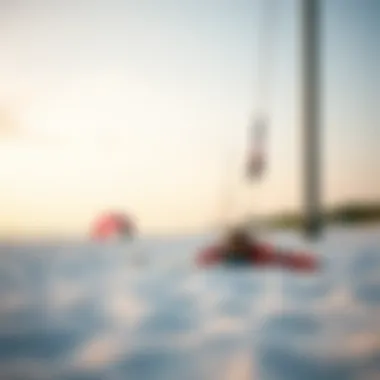
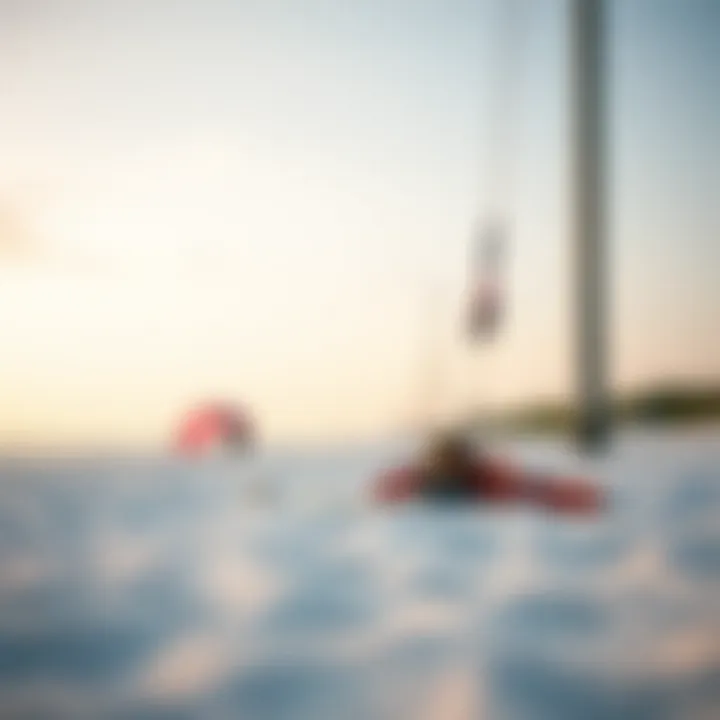
Benefits of taking beginner lessons include the opportunity to gain confidence, learn at a safe pace, and avoid any bad habits that can be hard to shake later. Moreover, instructors can provide useful insight into the unique conditions of the Maldives, like sudden wind shifts or local currents.
Advanced Techniques
As one progresses, moving into advanced techniques is where kite surfing really shines. Riders can polish skills like:
- Jumping: Learning the nuances of timing and kite positioning for height and control. This involves understanding how to preload the lines before leaping.
- Tricks and Spins: After mastering the basics, adding flair can be an exhilarating challenge. Riders often try to incorporate spins and grabs while airborne.
- Tack and Jibe: These maneuvers help in changing direction without losing speed. Jibing, in particular, is about making seamless turns while maintaining balance.
- Wave Riding: For those daring enough, riding waves is an advanced skill that adds another dimension to kite surfing. It requires a deep understanding of wave patterns and how to navigate them with the kite.
Advanced lessons equip riders with the tools to surf more efficiently and safely. As the techniques get increasingly sophisticated, the understanding of equipment, environmental factors, and local conditions comes into play. Equipment adjustments based on wind strength and conditions become second nature.
Whether struggling to stay upright or aiming for that perfect jump, merging learning with the enchanting backdrop of the Maldives ensures each rider's journey is uniquely fulfilling.
"Mastering kite surfing is not merely about riding the waves, it’s about developing a connection with nature. You start to read the wind and water like an open book."
Further resources for deepening your understanding are available at Wikipedia, as well as communities on Reddit for tips and experiences shared by fellow kite surfers.
Cultural Considerations in the Maldives
When kite surfing in the Maldives, understanding cultural considerations is paramount. The Maldives is not just a tropical paradise; it holds a rich tapestry of traditions, values, and beliefs shaped by its history and local customs. For kiteboarders, these cultural nuances can significantly enhance the experience and ensure respectful interactions with local communities.
Local Customs and Etiquette
The Maldives is a predominantly Muslim nation, and it’s essential to approach its local customs with sensitivity. Dress modestly when not on the beach or participating in water activities, especially in inhabited islands. Swimwear is acceptable on the beaches, but in villages, wearing more conservative attire is strongly advised. This not only shows respect for the community but also deepens the connection between kite surfers and the local way of life.
Before engaging with locals, take some time to learn about their customs, such as greeting with a friendly "As-salamu alaykum" and using polite language. Moreover, avoid public displays of affection, which might be frowned upon.
Respecting local traditions can foster goodwill and often lead to conversations that enrich your understanding of the culture. A kind gesture, like asking permission before taking a photo or learning a few phrases in the local Dhivehi language, can go a long way.
Engagement with Local Communities
Engagement with local communities is an avenue that kite surfers should embrace. Many islands offer the opportunity to interact with local residents who are more than willing to share their way of life. This interaction is not only rewarding but also beneficial for the local economy. Consider participating in local guided kite surf tours or workshops provided by residents. It can be a great way to learn more, improve your skills, and understand how the sport integrates into the life of Maldivians.
"Engaging with the community not only enhances your kite surfing experience but also uplifts the local economy, creating a win-win situation."
Look into responsible tourism practices, such as supporting local businesses by purchasing handmade crafts or dining at family-owned eateries. This engagement can help ensure that kite surfing remains a sustainable practice in the Maldives.
Tips for Engagement:
- Attend local festivals if your schedule allows, as these events are filled with authentic cultural experiences.
- Be open to learning from local surfers who have a unique perspective on the best spots and conditions.
- Participate in beach clean-ups or conservation efforts; these efforts are increasingly important as environmental consciousness grows.
By understanding and appreciating the vibrant culture of the Maldives, kite surfers not only enhance their own adventure but also contribute positively to the islands they cherish.
Safety Measures While Kite Surfing
Kite surfing in the Maldives can be an exhilarating adventure, but it doesn’t come without its risks. Practicing utmost safety is essential, not just for personal well-being but also for ensuring the experience remains enjoyable for everyone involved. With the right precautions, kite surfers can sail through the waters safely and make the most out of their kiteboarding ventures.
Understanding Local Regulations
Every region has its own set of rules and guidelines governing water sports, and the Maldives is no different. Familiarizing oneself with local regulations is critical before embarking on a kite surfing journey.
- Permits and Zones: Some areas may require permits for kite surfing, especially if designated zones are enforced. It’s wise to check with local authorities or kiteboarding schools to get up-to-date information.
- No-Go Areas: Many regions have specific zones where kite surfing is either restricted or completely banned. This typically includes areas near swimming zones, reefs, or where fishing activities are prevalent. Ignoring these regulations not only creates safety hazards but could also lead to hefty fines.
- Instructional Guidance: Engaging with local kiteboarding instructors can help you in understanding these regulations better. They not only impart essential knowledge about safety practices but can also ensure compliance with the rules of the water.
"Ignorance of the law excuses no one." Understanding local regulations ensures a safe kite surfing experience and fosters a strong relationship between kite surfers and the local community.
Preventative Care and First Aid
Being proactive with safety isn’t just about obeying regulations; it’s also about preparing for any potential mishaps. Having a solid plan for preventative care and first aid can make a significant difference in emergencies.
- Wear Protective Gear: Always use a helmet, impact vest, and sometimes even pads when kite surfing. These items can protect against unexpected falls and collisions.
- Basic First Aid Training: Taking a first aid course can equip kite surfers with the skills they need to handle minor injuries or emergencies at sea. Understanding how to treat cuts, sprains, or even how to perform CPR can be invaluable.
- Emergency Kit on Board: Carrying a basic first aid kit is wise. Essential items include band-aids, antiseptic wipes, pain relief medication, and any necessary personal medications. A whistle can also be a lifesaver in emergencies.
- Buddy System: It’s always better to surf with someone else. Not only does this provide companionship, but it also ensures there’s help at hand should something go awry. Communicating clearly with fellow surfers and agreeing on signals can enhance safety.
- Understanding Wind Conditions: Knowing how to read wind patterns and sea conditions is crucial. Wind can change rapidly in the Maldives, and recognizing these shifts early can help to avoid dangerous situations.
Ensuring safety while kite surfing doesn’t have to be a daunting task. With prepared gear, knowledge of local laws, and the proper first aid skills, kite surfers can glide over the waves with confidence and peace of mind.
Environmental Impact of Kite Surfing
Kite surfing in the Maldives offers thrilling experiences set against stunning natural backdrops, but its environmental implications warrant serious consideration. As kiteboarders, the responsibility extends beyond personal enjoyment; it's vital to recognize how our sport influences the delicate ecosystem surrounding this tropical paradise. The interaction between water sports and marine environments can lead to tangible benefits or detrimental effects, depending on how we approach our activities.
The conversation about the environmental footprints made by kiteboarding is essential in fostering a sustainable future for both the sport and the surrounding ecology. Unchecked growth in tourism and water sports can lead to habitat destruction, pollution, and disturbances to wildlife. Informed kite surfers can become advocates for sustainable practices, ensuring that the allure of the Maldives remains unmarred for generations to come.
"Sailing through these pristine waters, we must ask ourselves: how can we preserve this paradise as we ride the waves?"
To tackle the impacts head-on, it's crucial to adopt sustainability practices that prioritize environmental conservation while engaging in kite surfing. This allows riders to immerse themselves in nature without causing harm.
Sustainability Practices
Sustainability in kite surfing encompasses a range of actions and lifestyle choices that minimize negative ecological impacts. Here are a few ways kite surfers can engage in more sustainable practices:
- Eco-friendly Gear: Choose kites and boards made from sustainable materials, such as those produced using recycled components or biodegradable substances. Many brands are increasingly aligning with eco-conscious manufacturing processes, which can make a significant difference.
- Minimal Impact: Respect the natural environment by practicing minimal impact techniques. This includes landing on sandy beaches rather than coral reefs, which can severely damage marine habitats.
- Waste Management: Carry out what you bring in. Kite surfing can generate plastic waste from packaging and gear. Ensuring that all waste is properly disposed of or recycled goes a long way in keeping the beaches clean.
- Awareness and Education: Engage in local educational programs that promote awareness about environmental conservation. Being informed about the marine ecosystem can also enhance the overall kite surfing experience.
Protecting Marine Life
Marine life in the Maldives faces numerous challenges, and kite surfers have a unique opportunity to contribute to protective efforts. This involves understanding the crucial role that various species play in the ecosystem and the impacts kiteboarding activities can have on them.
- Respect Wildlife: When kitesurfing, always maintain a safe distance from marine animals like turtles and rays. Approaching them too closely can stress these creatures and disrupt their natural behaviors. The local dolphin pods and fish populations are not only beautiful to observe but also integral to the health of the oceans.
- Participate in Conservation Initiatives: Many local communities have conservation programs aimed at preserving marine habitats. Getting involved with these initiatives not only benefits the local environment but also fosters a deeper bond between kite surfers and the marine ecology.
- Report Pollution: If kite surfers encounter pollution, it's advisable to report it to local authorities or organizations. This helps facilitate timely cleanup efforts and raises awareness about ongoing environmental issues.
By adopting these practices, kite surfers can significantly lessen their environmental impact and help safeguard the beauty and biodiversity of the Maldives. In doing so, they embrace the responsibility of being stewards of the ocean while enjoying the thrill of riding its waves.
The Role of Kiteboarding Community
In the dynamic playground of kite surfing, the community holds a significant place. The thriving kiteboarding culture in the Maldives thrives due to the collective spirit of riders, instructors, and support staff. This vibrant network not only enhances the quality of the experience for newcomers but also contributes to the preservation and promotion of kiteboarding as a sport. Here’s an exploration of the two pivotal aspects that form the backbone of the kiteboarding community in the Maldives.
Local and Global Networks


The kiteboarding scene in the Maldives boasts a mix of local and global networks that foster camaraderie and shared passion among kite surfers. Locally, kite schools like Kiteboarding Maldives and Thulusdhoo Surf School enable riders to connect with experienced instructors who have grown up with the winds and waves of the region. Here, one finds an authentic connection to the art of kiteboarding, enriched with insights about the local environment.
On a global scale, social media platforms like Facebook and forums such as Reddit provide a bridge between kiteboarders from various corners of the world. These digital spaces foster discussions ranging from gear recommendations to travel tips. For instance, kite surfers can share their experiences about unexpected wind changes, or ideal launch spots. Such networks play a significant role in enhancing riders' knowledge and safety, ensuring everyone has access to valuable community wisdom.
"The community not only thrives on the waves but also on shared experiences, knowledge transfer, and friendships made across cultures."
Contribution to Local Economy
The kiteboarding community is not just a group of thrill-seekers; its impact on the local economy is profound. More than merely an adventure, kite surfing in the Maldives brings in tourism dollars, which ripple through the local economy.
- Job Creation: The surge in kiteboarding has led numerous local entrepreneurs to open shops that rent equipment and offer lessons. Local instructors gain valuable employment opportunities, directly benefiting from the influx of tourists.
- Hosting Competitions: Annual kite surfing competitions attract enthusiasts worldwide, infusing substantial revenue into hotels, restaurants, and transport services.
- Sustainable Practices: Engaging with local communities, kite schools are increasingly adopting environmentally-friendly practices. By promoting eco-friendly tourism, they not only protect the pristine waters of the Maldives but also encourage visitors to support local enterprises.
These financial benefits further highlight the symbiotic relationship between the kiteboarding community and the Maldives, serving as a reminder that every ride on the wave contributes to a larger narrative of responsibility and sustainability.
Travel Tips for Kite Surfers
When embarking on a kite surfing adventure in the Maldives, it’s paramount to be well-prepared. Knowledge isn’t just power; it’s the difference between a thrilling experience and a troublesome one. Travelers need to navigate not only the serene waters but also the intricacies of local amenities and cultural nuances. Planning plays a vital role in enhancing your kiteboarding escapade. From where to rest your head after a long day on the water to the best times to catch that elusive wind, each tip works on its own, but together they hold the keys to a smooth sailing experience.
Accommodations and Transport
Choosing the right accommodation can significantly enhance your kite surfing experience. In the Maldives, options span the entire spectrum, from luxurious resorts with kiteboarding schools to budget guest houses that offer laid-back atmospheres. It’s wise to consider location carefully. You want to be close to the prime kite spots to minimize transport time.
- Resorts with Kiteboarding Facilities: Places like Kandooma Resort or Adaaran Select Hudhuranfushi cater specifically to kite surfers, offering direct access to the water and organized trips.
- Guest Houses: Opt for local guest houses if you're looking to experience Maldivian culture more intimately. These often come with personalized tips from locals about the best kite locations.
- Transport:
- Domestic Flights: Reach your selected atoll via domestic flights or speedboats from Malé. This can sometimes be the quickest way to get there.
- Local Boats: Look into chartering local dhonis for a real experience of island hopping. They not only transport you to kite spots but also allow for an authentic Maldivian experience.
Keep in mind that the bending of schedules is common here, so remain flexible. Transport can be tricky, particularly during the monsoon season, affecting connections at various atolls.
Best Times to Visit
Timing is everything. For kite surfing, the Maldives offers distinct seasons defined by wind patterns. Understanding when to visit can significantly influence your experience in the water.
- High Season (December to March): This period is often ideal for experienced riders, with consistent winds ranging from 15 to 20 knots. Beach conditions are typically calm, and the weather is generally dry. However, expect more crowds and higher prices for accommodations.
- Shoulder Season (April to June): The wind conditions can be a bit more fickle during this time. It’s a great period for beginners as wind tends to be lighter, and it’s easier to learn.
- Low Season (July to November): This time is marked by unpredictable winds and may not be best for serious kite surfers. However, it’s perfect for travelers who want solitude and a chance to interact closely with local culture. Just remember to be aware of possible rain and storms, especially from May to August.
When planning your trip, consider both reliability in the wind and your own comfort preferences. Being forearmed with this knowledge can ensure that whether you’re just starting out or a seasoned pro, there’s always a favorable wind pushing you along.
"The Maldives can change quickly, so stay sharp and adjust accordingly!"
With the right tips in hand, travelers can enhance their kite surfing adventures and enjoy everything the Maldives has to offer, on and off the water.
Kite Surfing Etiquette
Kite surfing in the Maldives isn't just about riding the winds and waves; it's also about practicing good etiquette. Understanding and applying etiquette ensures everyone's experience is safe and enjoyable.
Respect for other riders is paramount in maintaining harmony on the water. When you’re sharing the ocean with fellow kite surfers, being aware of their presence and giving them space is fundamental. This respect not only establishes a positive vibe but also minimizes accidental collisions, which can be hazardous. Most kitesurfers appreciate when their fellow riders follow unwritten rules, such as maintaining proper distance and communicating effectively during maneuvers. This can be as simple as eye contact or a wave to signal your intentions.
Moreover, newcomers should be particularly mindful. They often bring enthusiasm but might not have a complete grasp of the nuances involved in shared kite surfing spaces. Therefore, understanding where to launch and land your kite without interfering with others is essential. To help foster this culture of respect, we can implement some simple strategies:
- Always check your surroundings before launching a kite, looking out for other riders or obstacles.
- Utilize hand signals to communicate with nearby kitesurfers about your movements.
- Avoid crossing through groups; take a longer route if needed.
Another aspect of kite surfing etiquette is navigating crowded waters. Popular spots in the Maldives can become busy, especially during peak season. Understanding the dynamics of crowded waters is crucial for every rider. For instance, to prevent accidents, it's wise to follow a consistent line of movement and avoid unpredictable turns in densely populated areas. This not only protects you but also ensures that others can predict your actions.
"Good etiquette is like good karma; what goes around, comes around. Respect others, and they won't hesitate to have your back when you need it."
When in crowded conditions, it's also beneficial to stay vigilant. This means keeping an eye on your kite's position and remaining aware of your surroundings. Educating yourself on how to navigate through busy lines while still enjoying the thrill is vital.
To encapsulate, practicing kite surfing etiquette establishes a code of conduct that enhances everyone’s enjoyment. Whether respecting other riders or navigating crowded waters, each individual contribution to the overall atmosphere is invaluable. The essence lies in fostering respect, communication, and awareness, ensuring that each outing remains a memorable adventure in the stunning backdrop of the Maldives.
For more insights on kite surfing and local conditions, consider visiting KiteSurfing.org or getting involved in community discussions on Reddit.
Future of Kite Surfing in the Maldives
As kite surfing continues to gain traction worldwide, the Maldives is poised to transform into a central hub for this thrilling sport. With its stunning landscapes and favorable conditions, the future of kite surfing in this archipelago seems not just bright, but also incredibly promising. Awareness around water sports is rising, driven by tourism and social media, which could lead to an increase in both local interest and international travelers.
The growing popularity highlights several elements of concern and consideration, especially when discussing developments in infrastructure, community benefits, and environmental sustainability. In this article section, we will explore these aspects closely, digging into how they intertwine with the sport's evolution.
Predicted Developments
The kite surfing scene in the Maldives is likely to experience several noteworthy developments in the coming years:
- Enhanced Infrastructure: Anticipation surrounds improved facilities such as kite schools, rental shops, and accommodations styled especially for kite surfers. Enhanced access to these facilities ensures that both novices and experienced riders can comfortably engage in their sport.
- Increased Local Engagement: As kite surfing becomes more mainstream, local communities might start to engage more actively in the sport. Surfers are likely to forge stronger relationships with Maldivian locals, creating a symbiotic relationship where both parties benefit from increased cultural exchange and economic stimulation.
- Sustainable Practices: The demand for eco-conscious practices is likely to rise alongside the sport's popularity. This may lead to more kite surfing schools adopting sustainable methods, from using eco-friendly equipment to organizing clean-up initiatives in popular kite surfing locations.
Trends in Equipment and Techniques
Innovation in kite surfing gear and techniques can profoundly impact the way the sport evolves.
- Lightweight Materials: Manufacturers are focusing on lighter and more durable materials for kites and boards, improving performance and maneuverability. This makes the sport approachable for a wider audience, alleviating concerns related to physical exertion.
- Safety Features: As the number of participants grows, safety equipment enhancements will likely follow suit. Advanced harnesses with better support, depower systems, and quick release mechanisms may become the norm, minimizing risks for beginners and seasoned riders alike.
- Adaptive Techniques: With more individuals taking an interest in kite surfing, instructors are increasingly focusing on adaptive techniques suited for all skill levels. The rise of new training programs means novice kite surfers will benefit from a broader array of instructional methods, providing them with the tools to progress rapidly.
"The future of kite surfing in the Maldives is not just about riding the waves; it’s about riding them responsibly."
In so many ways, kite surfing's future in the Maldives mirrors the broader trend of adventure sports, bringing together thrill-seekers and nature lovers for a common purpose. With thoughtful development, the possibilities are endless.
End
As we wrap up our exploration of kite surfing in the Maldives, it’s clear that this picturesque destination offers more than just stunning views and warm breezes. The combination of favorable wind conditions, diverse geographical features, and a rich cultural backdrop creates an extraordinary environment for both novice and seasoned kite surfers. Understanding the local customs and practices not only enriches the experience but also fosters a sense of community among enthusiasts.
In reviewing the various elements detailed throughout the article, several key benefits emerge. First, kiteboarding in the Maldives isn’t solely about the thrill of riding the waves; it’s also about the connection to nature and the local culture. Engaging with the local community, understanding environmental impacts, and practicing sustainable habits play crucial roles in preserving the unspoiled beauty of this island chain.
Furthermore, the insights into safety measures and essential gear give kite surfers the tools necessary for a responsible and enjoyable experience. With proper knowledge, riders can tackle the waters with confidence, ensuring their well-being while also respecting the marine ecosystem.
Ultimately, kite surfing in the Maldives serves as a unique fusion of adventure and mindfulness. It encourages a lifestyle that values exploration coupled with an appreciation for the aquatic environment. For those looking to cast their lines into the delightful winds of this exotic location, the journey promises to be both exhilarating and enriching. Like they say, "you can't buy happiness, but you can buy a kite board, and that's pretty close."
Kite surfing isn’t just a sport; it’s an encounter with nature, culture, and oneself.
In the grand scheme of kiteboarding, the Maldives stands out not just for its conditions but for the holistic experience it offers. For anyone looking to elevate their adventure, understanding these intricacies is paramount.
Learning to kite surf in the Maldives is an investment in both skill and memories. As the sun dips below the horizon, painting the sky in hues of orange and pink, it’s this balance of excitement and tranquility that encapsulates what kite surfing in this paradise truly means. Every ride is an opportunity to connect with the water, the wind, and the spirit of adventure.

